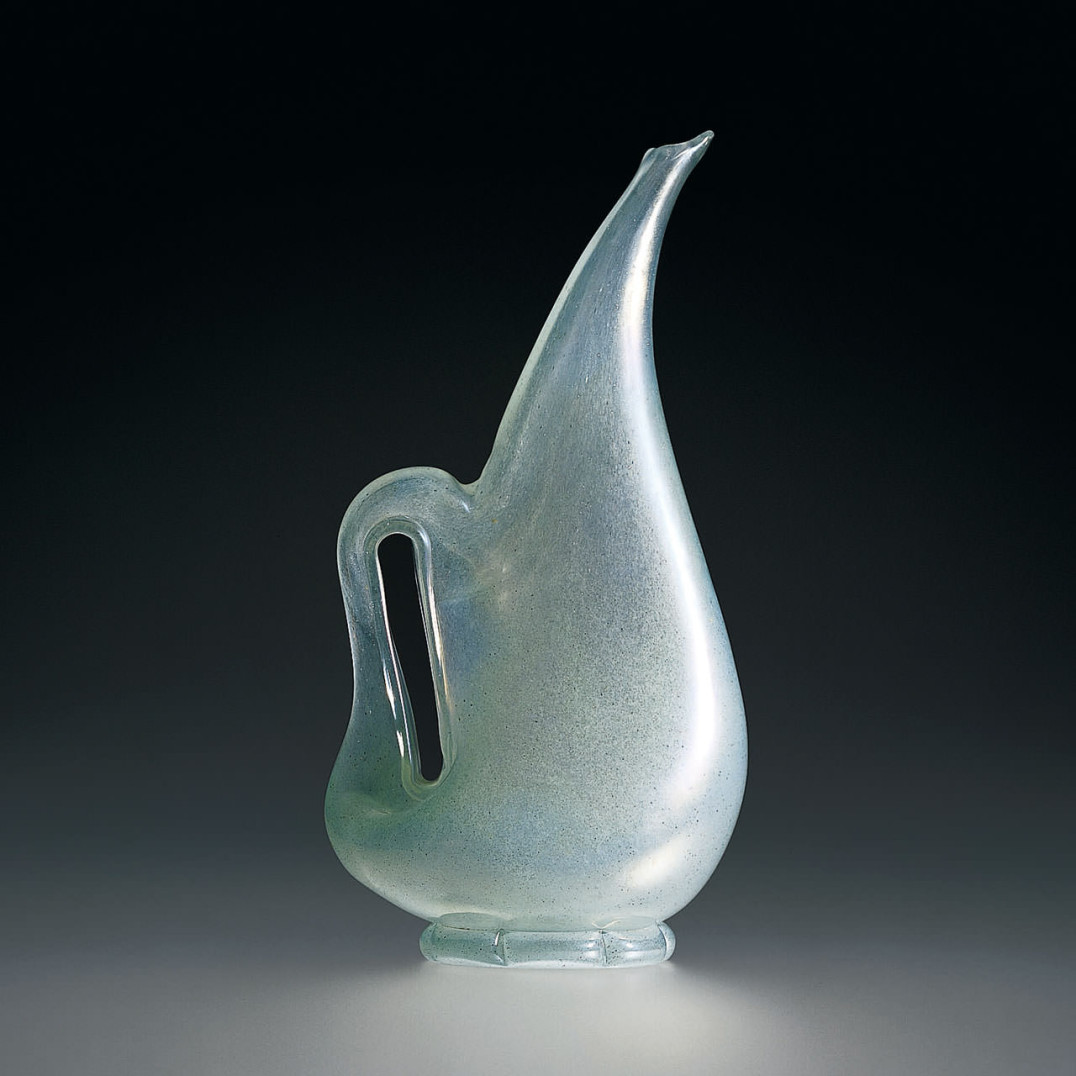
Ercole BarovierEugeneo, 1951
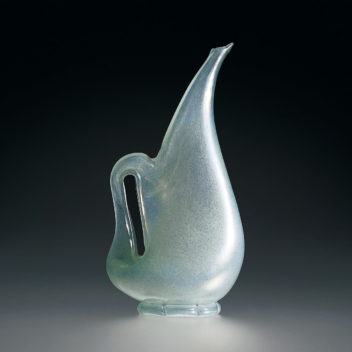
Ercole BarovierEugeneoBarovier & Toso, 1951
Footed vessel with a vertical aperture to create a handle composed of strongly iridized pearl-colored glass, the surface coloring obtained with the technique of colorazione a caldo senza fusione.
14 1/4 in. high (36.2 cm)
Exhibitions:
1952, Venice, 26th Biennale Internazionale d’Arte;
2000, New York, Venetian Glass, Museum of Arts & Design;
2001, Milan, Murano: Vetri dalla Collezione Olnick Spanu, Spazio Oberdan.
Bibliography and comparative texts:
B. Nerozzi, 1987, n. 66;
A. Dorigato, 1989, nn. 80-81;
M. Heiremans, 1989, n. 40;
M. Karasik, 1989, n. 35;
R. Barovier Mentasti, 1992, n. 86;
L’arte del vetro…, 1992, n. 373;
M. Barovier, 1993, n. 129;
M. Barovier, R. Barovier Mentasti,
A. Dorigato, 1995, n. 93;
F. Deboni, 1996, n. 43;
H. Ricke, E. Schmitt, 1996, n. 259;
Olnick Spanu, 2000, n. 123;
Olnick Spanu, 2001, n. 162
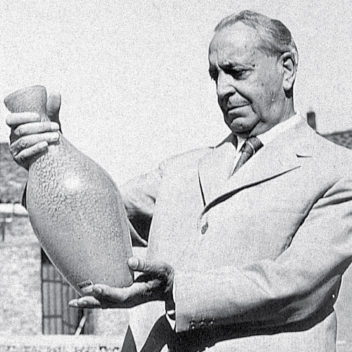
Ercole Barovier 1889–1974
Entrepreneur and designer Ercole Barovier was the son of Benvenuto Barovier. At age 30, he became a partner in his father's company, the Vetreria Artistica Barovier & C. After becoming its artistic director in 1926, he took over its management with his brother. He became sole proprietor in 1936, engineering the fusion between his own glass workshop and the S.A.I.A.R. Ferro-Toso. In 1942, the new company was renamed Barovier & Toso and Ercole maintained artistic direction until 1972. His first major successes date back to the '20s; first with the murrine vessels, then with totally original creations such as the Primavera glass collection of 1929-30. After the 30s, he dedicated himself entirely to experimenting with new multi-colored effects. In addition he perfected the colorazione a caldo senza fusione which he first used in 1935-36 to create the series Crepuscolo, Autunno Gemmato, Marina Gemmata, and Laguna Gemmata. Before World War II, he preferred soft shapes and rather thick materials, whereas in the postwar period his interest turned specifically to the field of traditional techniques, which he continued to reinterpret through his very last creations with the series A Tessere in 1972. In the '50s, his work distinguished itself, both for the vivid quality of its colors as well as for the singularity of the materials noted for the rawness of their surfaces like the barbarici. During the '60s and '70s, he gave new interpretations of his a tessere glass with the Dorici, Caccia, Rotellati, and other series, which were characterized by unusual color combinations.
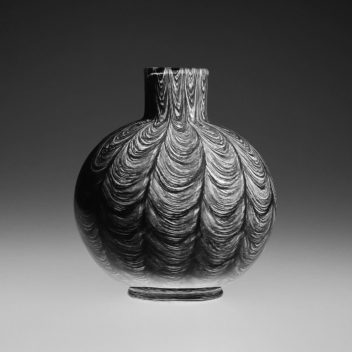
Barovier & Toso 1942–
In 1936, Ercole Barovier became partner of the S.A.I.A.R. Ferro Toso, forming Ferro Toso e Barovier. In 1939, it became Barovier Toso & C., and finally, in 1942, its name was changed to Barovier & Toso. Ercole Barovier remained artistic director of the company through 1972 and was succeeded by his son, Angelo, who was already a designer for the company. Beginning in the '80s and continuing through today, many have designers collaborated with Barovier & Toso. Among them are Matteo Thun, Toni Zuccheri, Renato and Giusto Toso, and Noti Massari. The company’s most recent productions have been created by designers like Roberto Caddeo, Marco Mencacci, Franco Raggi, Luca Scacchetti, and others. Barovier & Toso is currently directed by Angelo, his son Jacopo, and Giovanni Toso.
Ercole BarovierEugeneo, 1951
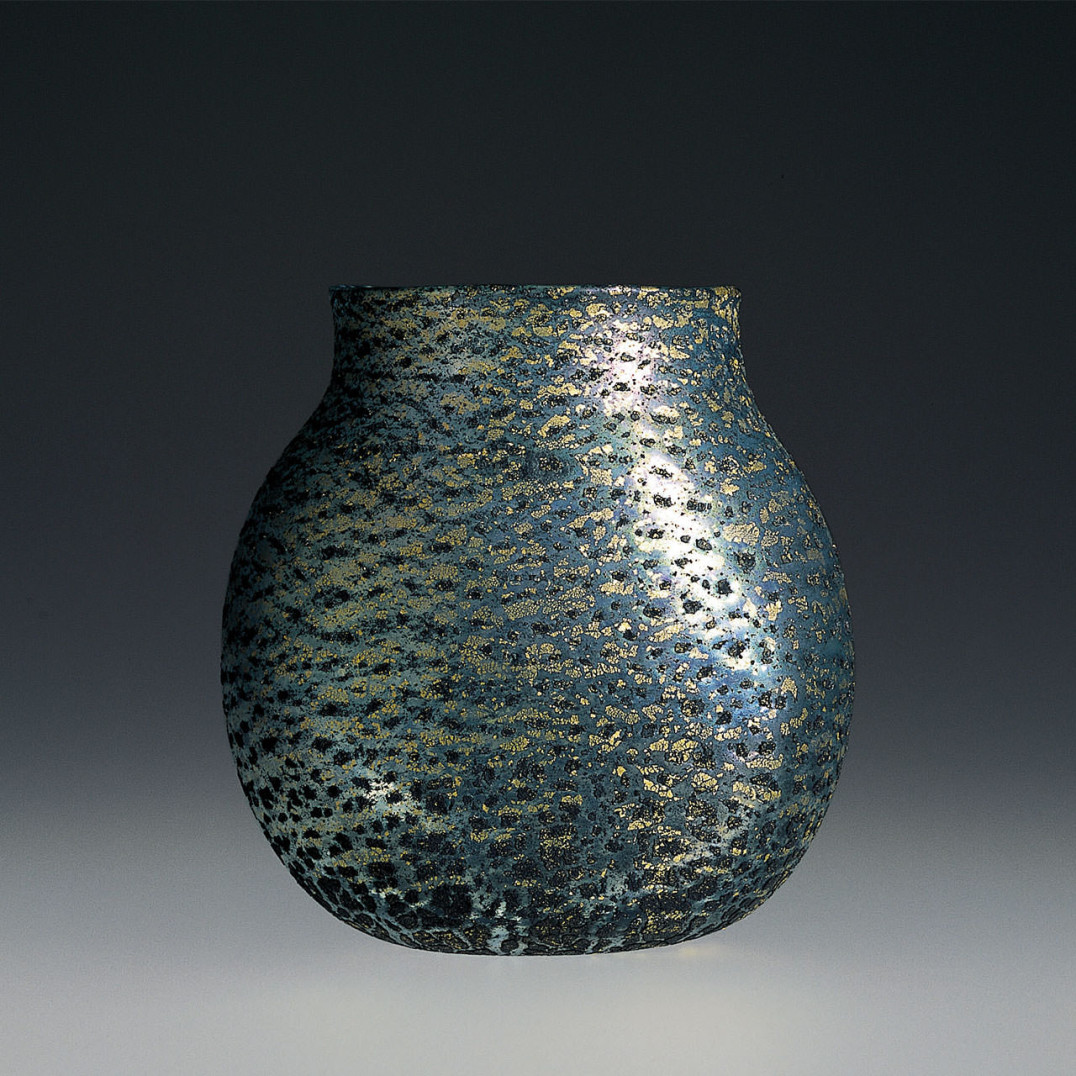
Ercole BarovierBarbarico, 1951
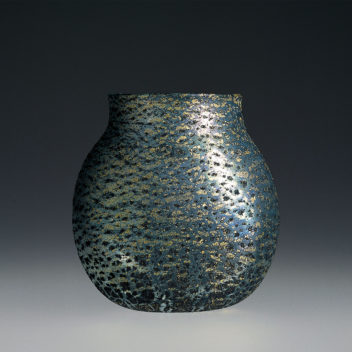
Ercole BarovierBarbaricoBarovier & Toso, 1951
Small, cobalt blue glass vessel, the rough gold surface obtained with the application of gold leaf and the technique of the colorazione a caldo senza fusione.
6 1/8 in. high (15.6 cm)
Exhibitions:
1951, Milan, 9th Triennale;
1952, Venice, 26th Biennale Internazionale d’Arte;
2000, New York, Venetian Glass, Museum of Arts & Design;
2001, Milan, Murano: Vetri dalla Collezione Olnick Spanu, Spazio Oberdan.
Bibliography and comparative texts:
Domus, 1951, October;
R. Aloi, 1952, n. 25;
A. Dorigato, 1989, n. 82;
M. Heiremans, 1989, n. 35;
M. Karasik, 1989, n. 35;
L’arte del vetro…, 1992, n. 374;
M. Barovier, 1993, n. 132;
M. Heiremans, 1993, n. 43;
M. Barovier, R. Barovier Mentasti,
A. Dorigato, 1995, n. 92;
F. Deboni, 1996, n. 41;
H. Ricke, E. Schmitt, 1996, n. 258;
R. Barovier Mentasti, 1998, n. 101;
M. Barovier, 1999, p. 195;
Olnick Spanu, 2000, n. 122;
Olnick Spanu, 2001, n. 161.

Ercole Barovier 1889–1974
Entrepreneur and designer Ercole Barovier was the son of Benvenuto Barovier. At age 30, he became a partner in his father's company, the Vetreria Artistica Barovier & C. After becoming its artistic director in 1926, he took over its management with his brother. He became sole proprietor in 1936, engineering the fusion between his own glass workshop and the S.A.I.A.R. Ferro-Toso. In 1942, the new company was renamed Barovier & Toso and Ercole maintained artistic direction until 1972. His first major successes date back to the '20s; first with the murrine vessels, then with totally original creations such as the Primavera glass collection of 1929-30. After the 30s, he dedicated himself entirely to experimenting with new multi-colored effects. In addition he perfected the colorazione a caldo senza fusione which he first used in 1935-36 to create the series Crepuscolo, Autunno Gemmato, Marina Gemmata, and Laguna Gemmata. Before World War II, he preferred soft shapes and rather thick materials, whereas in the postwar period his interest turned specifically to the field of traditional techniques, which he continued to reinterpret through his very last creations with the series A Tessere in 1972. In the '50s, his work distinguished itself, both for the vivid quality of its colors as well as for the singularity of the materials noted for the rawness of their surfaces like the barbarici. During the '60s and '70s, he gave new interpretations of his a tessere glass with the Dorici, Caccia, Rotellati, and other series, which were characterized by unusual color combinations.

Barovier & Toso 1942–
In 1936, Ercole Barovier became partner of the S.A.I.A.R. Ferro Toso, forming Ferro Toso e Barovier. In 1939, it became Barovier Toso & C., and finally, in 1942, its name was changed to Barovier & Toso. Ercole Barovier remained artistic director of the company through 1972 and was succeeded by his son, Angelo, who was already a designer for the company. Beginning in the '80s and continuing through today, many have designers collaborated with Barovier & Toso. Among them are Matteo Thun, Toni Zuccheri, Renato and Giusto Toso, and Noti Massari. The company’s most recent productions have been created by designers like Roberto Caddeo, Marco Mencacci, Franco Raggi, Luca Scacchetti, and others. Barovier & Toso is currently directed by Angelo, his son Jacopo, and Giovanni Toso.
Ercole BarovierBarbarico, 1951
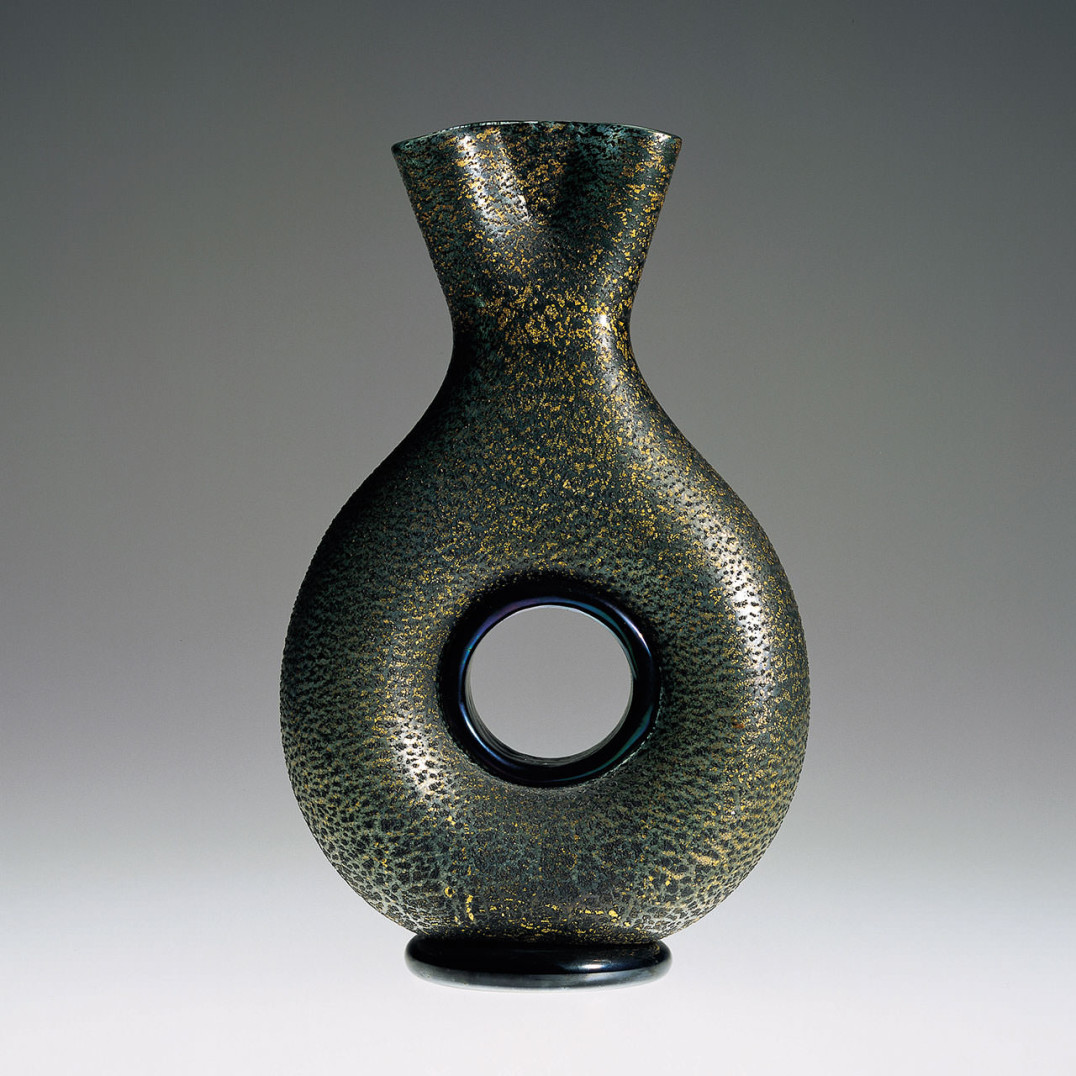
Ercole BarovierBarbarico, 1951

Ercole BarovierBarbaricoBarovier & Toso, 1951
A footed vessel with one large aperture and a pinched mouth. The rough gold surface of the cobalt blue glass vessel is obtained with the application of gold leaf and the technique of colorazione a caldo senza fusione.
11 1/2 in. high (29.2 cm)
Exhibitions:
1951, Milan, 9th Triennale;
1952, Venice, 26th Biennale Internazionale d’Arte;
2000, New York, Venetian Glass, Museum of Arts & Design;
2001, Milan, Murano: Vetri dalla Collezione Olnick Spanu, Spazio Oberdan.
Bibliography and comparative texts:
Domus, 1951, October;
R. Aloi, 1952, n. 25;
A. Dorigato, 1989, n. 82;
M. Heiremans, 1989, n. 35;
M. Karasik, 1989, n. 35;
L’arte del vetro…, 1992, n. 374;
M. Barovier, 1993, n. 132;
M. Heiremans, 1993, n. 43;
M. Barovier, R. Barovier Mentasti,
A. Dorigato, 1995, n. 92;
F. Deboni, 1996, n. 41;
H. Ricke, E. Schmitt, 1996, n. 258;
R. Barovier Mentasti, 1998, n. 101;
M. Barovier, 1999, p. 195;
Olnick Spanu, 2000, n. 121;
Olnick Spanu, 2001, n. 160.

Ercole Barovier 1889–1974
Entrepreneur and designer Ercole Barovier was the son of Benvenuto Barovier. At age 30, he became a partner in his father's company, the Vetreria Artistica Barovier & C. After becoming its artistic director in 1926, he took over its management with his brother. He became sole proprietor in 1936, engineering the fusion between his own glass workshop and the S.A.I.A.R. Ferro-Toso. In 1942, the new company was renamed Barovier & Toso and Ercole maintained artistic direction until 1972. His first major successes date back to the '20s; first with the murrine vessels, then with totally original creations such as the Primavera glass collection of 1929-30. After the 30s, he dedicated himself entirely to experimenting with new multi-colored effects. In addition he perfected the colorazione a caldo senza fusione which he first used in 1935-36 to create the series Crepuscolo, Autunno Gemmato, Marina Gemmata, and Laguna Gemmata. Before World War II, he preferred soft shapes and rather thick materials, whereas in the postwar period his interest turned specifically to the field of traditional techniques, which he continued to reinterpret through his very last creations with the series A Tessere in 1972. In the '50s, his work distinguished itself, both for the vivid quality of its colors as well as for the singularity of the materials noted for the rawness of their surfaces like the barbarici. During the '60s and '70s, he gave new interpretations of his a tessere glass with the Dorici, Caccia, Rotellati, and other series, which were characterized by unusual color combinations.

Barovier & Toso 1942–
In 1936, Ercole Barovier became partner of the S.A.I.A.R. Ferro Toso, forming Ferro Toso e Barovier. In 1939, it became Barovier Toso & C., and finally, in 1942, its name was changed to Barovier & Toso. Ercole Barovier remained artistic director of the company through 1972 and was succeeded by his son, Angelo, who was already a designer for the company. Beginning in the '80s and continuing through today, many have designers collaborated with Barovier & Toso. Among them are Matteo Thun, Toni Zuccheri, Renato and Giusto Toso, and Noti Massari. The company’s most recent productions have been created by designers like Roberto Caddeo, Marco Mencacci, Franco Raggi, Luca Scacchetti, and others. Barovier & Toso is currently directed by Angelo, his son Jacopo, and Giovanni Toso.
Ercole BarovierBarbarico, 1951
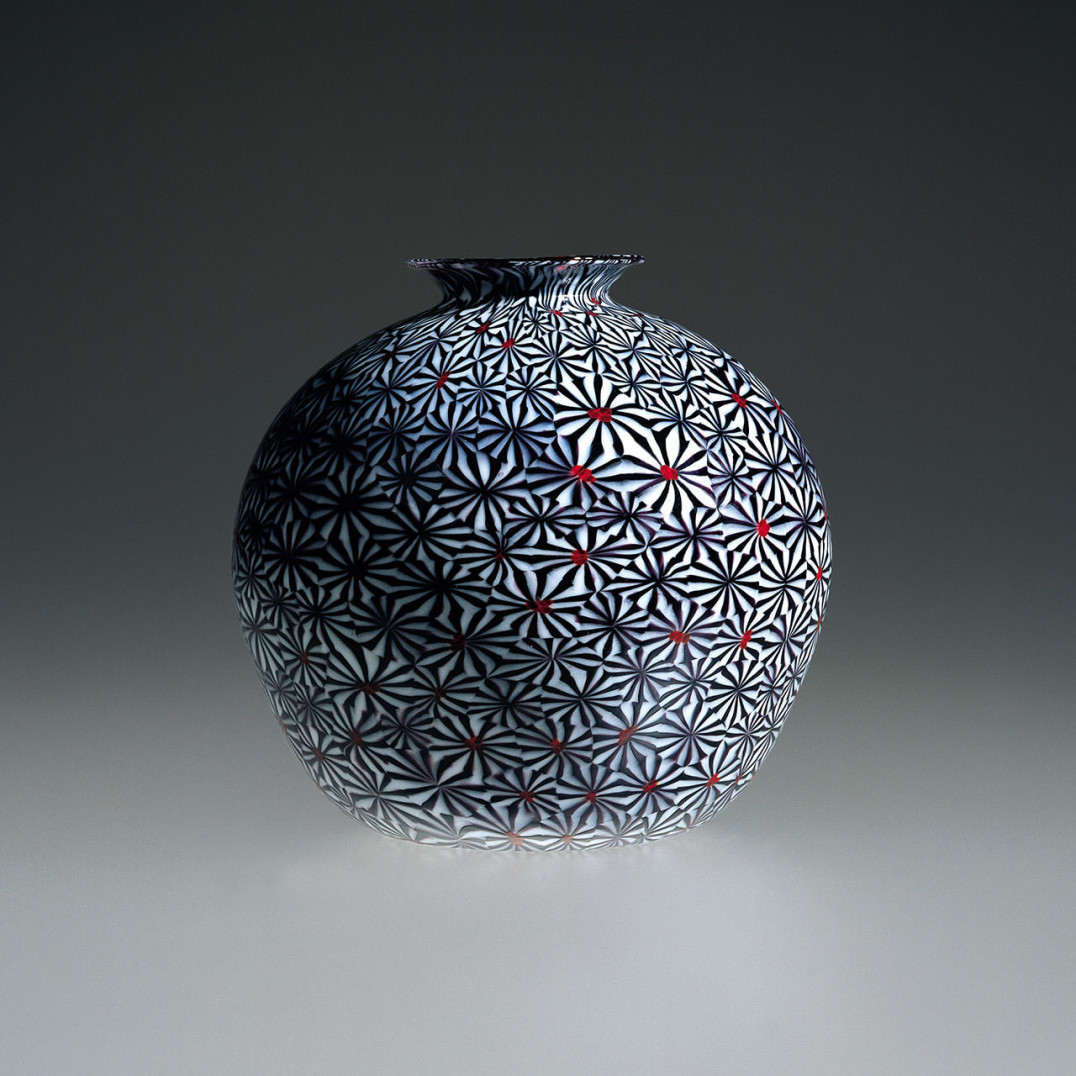
Ermanno TosoKiku, 1959-1960
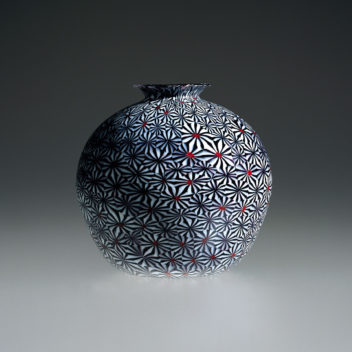
Ermanno TosoKikuFratelli Toso, 1959-1960
Globular glass vase crafted with aubergine and lattimo pinwheel murrine, most of which have a red glass core.
7 in. high (17.8 cm)
Exhibitions:
2000, New York, Venetian Glass, Museum of Arts & Design;
2001, Milan, Murano: Vetri dalla Collezione Olnick Spanu, Spazio Oberdan.
Bibliography and comparative texts:
M. Heiremans, 1989, nn. 163, 164;
Olnick Spanu, 2000, n. 120;
Olnick Spanu, 2001, n. 159.
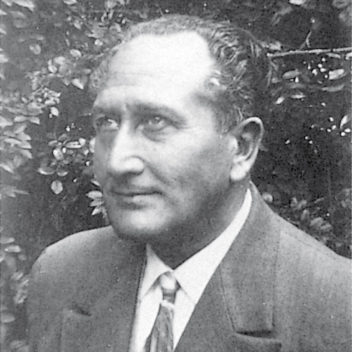
Ermanno Toso 1903–1973
Born on Murano, Ermanno Toso began to work at the Fratelli Toso workshop in 1924, where he was later to become a partner. In 1936, he was named artistic and marketing director of the company. During the period preceding World War II, he created thick glass pieces using traditional decorative techniques that were characterized by simple and solid shapes inspired by the Novecento style. During the '50s, he created a collection of extraordinarily lightweight glass pieces based on a modern interpretation of classical techniques, such as filigrana and murrina. During the '60s, his creative talent led him towards an absolute multicolored sobriety.
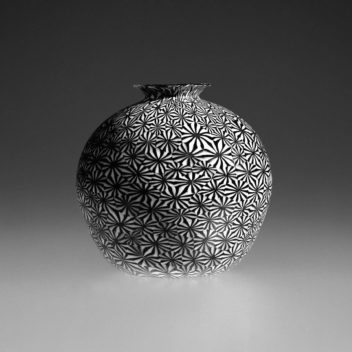
Fratelli Toso 1954–1982
Founded in 1854 by the brothers Ferdinando, Carlo, Liberato, Angelo, Giovanni, and Gregorio Toso, Fratelli Toso initially produced pharmaceutical bottles for domestic use. These were soon followed by reproductions of antique glass pieces. In the early 1900s, the company produced objects and chandeliers in the floral style executed with the murrine technique. In 1912 and 1914, Fratelli Toso obtained great success at the Biennale di Venezia by presenting works by the Norwegian artist Hans Stoltberg Lerche. In 1934, however, a remarkable change was noted in their work presented at the Biennale di Venezia. In 1936, the artistic direction of the company was assumed by Ermanno Toso, who progressively revisited the techniques of Murano glass, reinterpreting them in a personal style. These works received widespread acclaim, especially after World War II. During the '60s and '70s, the works of Renato, Giusto and Rosanna Toso, who often used transparent glass, brought a decidedly modern look to the company. The furnace was closed in 1982.
Ermanno TosoKiku, 1959-1960
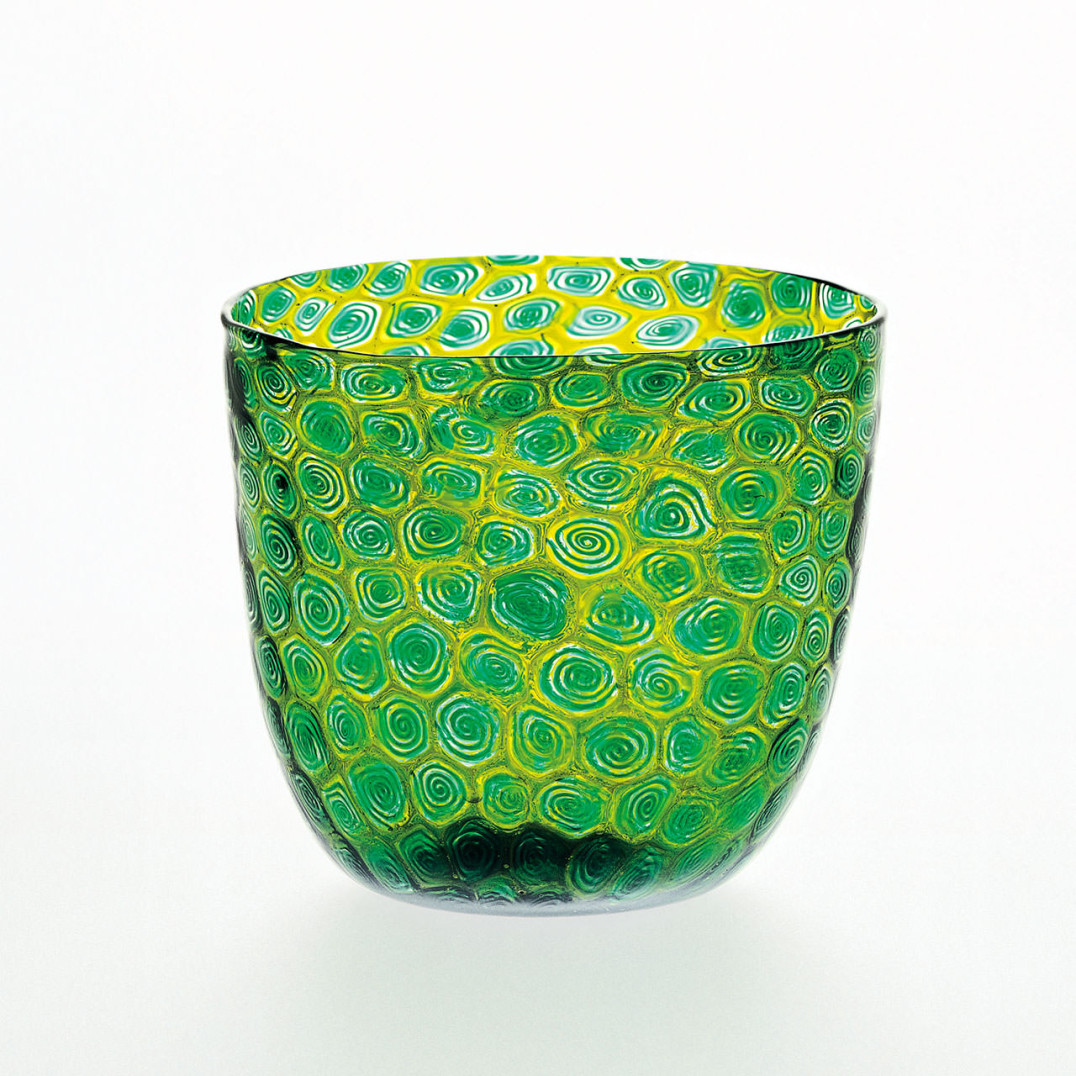
Ermanno TosoMurrine spiraliformi, 1960-1962
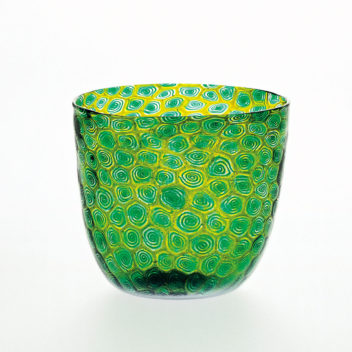
Ermanno TosoMurrine spiraliformiFratelli Toso, 1960-1962
Bowl composed of green, blue, and yellow spiraled murrine.
Original paper label: Murano Glass Made in Italy.
5 1/2 in. high (14 cm)
Exhibitions:
1962, Venice, 31st Biennale Internazionale d’Arte;
1963, Venice, Exhibition of Murano Glass, Opera Bevilacqua La Masa;
2000, New York, Venetian Glass, Museum of Arts & Design;
2001, Milan, Murano: Vetri dalla Collezione Olnick Spanu, Spazio Oberdan.
Bibliography and comparison texts:
Mostra del vetro…, 1963;
M. Heiremans, 1989, nn. 158, 159;
M. Barovier, R. Barovier Mentasti,
A. Dorigato, 1995, p. 141;
F. Deboni, 1996, n. 170;
M. Heiremans, 1996, n. 219;
M. Barovier, 1999, p. 258;
Olnick Spanu, 2000, n. 119;
Olnick Spanu, 2001, n. 158.

Ermanno Toso 1903–1973
Born on Murano, Ermanno Toso began to work at the Fratelli Toso workshop in 1924, where he was later to become a partner. In 1936, he was named artistic and marketing director of the company. During the period preceding World War II, he created thick glass pieces using traditional decorative techniques that were characterized by simple and solid shapes inspired by the Novecento style. During the '50s, he created a collection of extraordinarily lightweight glass pieces based on a modern interpretation of classical techniques, such as filigrana and murrina. During the '60s, his creative talent led him towards an absolute multicolored sobriety.

Fratelli Toso 1954–1982
Founded in 1854 by the brothers Ferdinando, Carlo, Liberato, Angelo, Giovanni, and Gregorio Toso, Fratelli Toso initially produced pharmaceutical bottles for domestic use. These were soon followed by reproductions of antique glass pieces. In the early 1900s, the company produced objects and chandeliers in the floral style executed with the murrine technique. In 1912 and 1914, Fratelli Toso obtained great success at the Biennale di Venezia by presenting works by the Norwegian artist Hans Stoltberg Lerche. In 1934, however, a remarkable change was noted in their work presented at the Biennale di Venezia. In 1936, the artistic direction of the company was assumed by Ermanno Toso, who progressively revisited the techniques of Murano glass, reinterpreting them in a personal style. These works received widespread acclaim, especially after World War II. During the '60s and '70s, the works of Renato, Giusto and Rosanna Toso, who often used transparent glass, brought a decidedly modern look to the company. The furnace was closed in 1982.